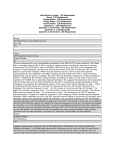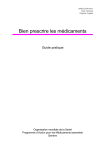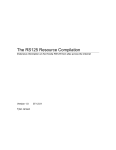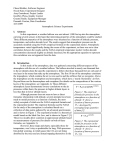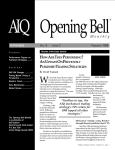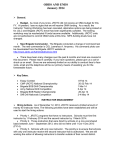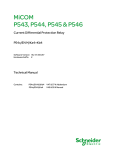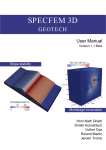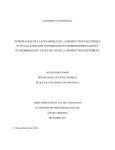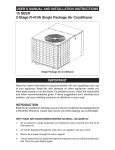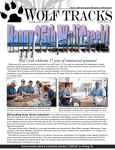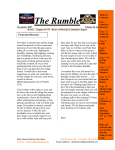Download Consideration of Comments
Transcript
Consideration of Comments Project 2011-INT-02 Interpretation of VAR-002 for Constellation The 2011-INT-02 Drafting Team thanks all commenters who submitted comments on Draft 2 of VAR1 002-2b, rapid revision project. These standards were posted for a 38-day formal comment period from May 22, 2012 through June 27, 2012, with a successive ballot during the last ten days of the comment period. Stakeholders were asked to provide feedback on the standards and associated documents through a special electronic comment form. There were 35 sets of comments, including comments from approximately 112 different individuals from approximately 76 companies representing all 10 Industry Segments as shown in the table on the following pages. All comments submitted may be reviewed in their original format on the standard’s project page: http://www.nerc.com/filez/standards/Project_2011-INT-02_Int_of_VAR-002_for_Const.html If you feel that your comment has been overlooked, please let us know immediately. Our goal is to give every comment serious consideration in this process! If you feel there has been an error or omission, you can contact the Vice President of Standards and Training, Herb Schrayshuen, at 404-446-2560 or at [email protected]. In addition, there is a NERC Reliability Standards Appeals Process.2 Summary Consideration: The Standard Drafting Team received several suggestions for revisions to the language of the standard. The SDT believes that stakeholder consensus has been achieved with respect to standard language and does not believe further edits are necessary at this time. The SDT does acknowledge that there may be room for improvement in the language and will have these comments included in the NERC Issues database for the VAR-002 standard. This will be included in the scope of work for the Project 2008-01 drafting team to consider in its revisions to the standard. Several commenters suggested revisions to the VSL for Requirement R2. It was suggested that the timing elements of the VSLs be in-line with Requirement R3, which allows the Generator Operator 30 minutes to notify the Transmission Operator of changes in the status or capability of reactive resources. Requirement R2 does not build in a 30-minute window, as Requirement R3 does, so the SDT notes that the VSLs must apply after a violation has been identified and therefore the “floor” must be at zero (not 30 minutes). Still, the he SDT agrees that the timeframes in the VSL for Requirement R2 should be extended and has revised the timing elements of the VSLs as follows: 1 The posting was for a 30-day comment period, but the period was extended when NERC learned that a technology malfunction had resulted in the announcement of the opening of the comment not being properly distributed. 2 The appeals process is in the Standard Processes Manual: http://www.nerc.com/files/Appendix_3A_StandardsProcessesManual_20120131.pdf Lower: When directed by the Transmission Operator to maintain the generator voltage or reactive power schedule the Generator Operator failed to meet the directed values for up to and including 45 minutes. Moderate: When directed by the Transmission Operator to maintain the generator voltage or reactive power schedule the Generator Operator failed to meet the directed values for more than 45 minutes up to and including 60 minutes. High: When directed by the Transmission Operator to maintain the generator voltage or reactive power schedule the Generator Operator failed to meet the directed values for more than 60 minutes up to and including 75 minutes. Severe: When directed by the Transmission Operator to maintain the generator voltage or reactive power schedule the Generator Operator failed to meet the directed values for more than 75 minutes. A couple of commenters suggested that the VSLs include a percentage deviation from the schedule. The original VSLs addressed being off by certain percentages, however, the SDT discussed this prior to the last posting and decided to remove the percentage references. A voltage schedule may be conducive to a VSL that uses percentage deviations, but a Reactive Power schedule may not. In the case where the Reactive Power schedule is very small (e.g., 1 MVAR), it would be impossible for a Generator Operator to comply unless the tolerance band were quite large. The SDT believes that this sort of VSL would be impossible to craft given the varying schedules that could be developed for the different size units on the BES. Therefore, the SDT decided to remove the percentage-based VSLs. Consideration of Comments: Project 2011-INT-02 2 Index to Questions, Comments, and Responses 1. The scope of the SDT has been revised to address deficiencies in Requirement R2 and its associated VSLs. Do you agree with the proposed revisions to Requirement R2 and its VSLs? If No, please explain your concerns.…. ......................................................................................................... 9 2. If you have any other comments on the SAR or on the proposed Standard that you have not provided above, please provide them here. …. ................................................................................ 27 Consideration of Comments: Project 2011-INT-02 3 The Industry Segments are: 1 — Transmission Owners 2 — RTOs, ISOs 3 — Load-serving Entities 4 — Transmission-dependent Utilities 5 — Electric Generators 6 — Electricity Brokers, Aggregators, and Marketers 7 — Large Electricity End Users 8 — Small Electricity End Users 9 — Federal, State, Provincial Regulatory or other Government Entities 10 — Regional Reliability Organizations, Regional Entities Group/Individual Commenter Organization Registered Ballot Body Segment 1 1. Group Additional Member Guy Zito Northeast Power Coordinating Council Additional Organization Region Segment Selection 1. Alan Adamson New York State Reliability Council, LLC NPCC 10 2. Greg Campoli New York Independent System Operator NPCC 2 3. Sylvain Clermont Hydro-Quebec TransEnergie NPCC 1 4. Chris de Graffenried Consolidated Edison Co. of New York, Inc. NPCC 1 5. Gerry Dunbar Northeast Power Coordinating Council NPCC 10 6. Mike Garton Dominion Resources Services, Inc. NPCC 5 7. Kathleen Goodman ISO - New England NPCC 2 8. Michael Jones National Grid NPCC 1 9. David Kiguel Hydro One Networks Inc. NPCC 1 10. Michael R. Lombardi Northeast Utilities NPCC 1 2 3 4 5 6 7 8 9 10 X Group/Individual Commenter Organization Registered Ballot Body Segment 1 11. Randy MacDonald New Brunswick Power Transmission NPCC 9 12. Bruce Metruck New York Power Authority NPCC 6 13. Silvia Parada Mitchell NextEra Energy, LLC NPCC 5 14. Lee Pedowicz Northeast Power Coordinating Council NPCC 10 15. Robert Pellegrini The United Illuminating Company NPCC 1 16. Si Truc Phan Hydro-Quebec TransEnergie NPCC 1 17. David Ramkalawan Ontario Power Generation, Inc. NPCC 5 18. Brian Robinson Utility Services NPCC 8 19. Michael Schiavone National Grid NPCC 1 20. Wayne Sipperly New York Power Authority NPCC 5 21. Tina Teng Independent Electricity System Operator NPCC 2 22. Donald Weaver New Brunswick System Operator NPCC 2 23. Ben Wu Orange and Rockland Utilities NPCC 1 24. Peter Yost Consolidated Edison Co. of New York, Inc. NPCC 3 2. Robert Rhodes Group Additional Member SPP Standards Review Group Additional Organization City Utilities of Springfield SPP 1, 4 2. Ron Gunderson Nebraska Public Power District MRO 1, 3, 5 3. Tara Lightner Sunflower Electric Power Corporation SPP 1 4. Dan Lusk Xcel Energy 1, 3, 5, 6 5. Jerry McVey Sunflower Electric Power Corporation SPP 1 6. Randy Root Grand River Dam Authority 1, 3, 5 7. Chad Wasinger Sunflower Electric Power Corporation SPP 1 8. Terri Pyle Oklahoma Gas & Electric 1, 3, 5 Group SPP SPP SPP Greg Rowland 3 4 5 6 7 X Region Segment Selection 1. John Allen 3. 2 Duke Energy X X X X X X Additional Member Additional Organization Region Segment Selection 1. Doug Hils Duke Energy RFC 1 2. Ed Ernst Duke Energy SERC 3 3. Dale Goodwine Duke Energy SERC 5 4. Greg Cecil Duke Energy RFC 6 4. Group Will Smith MRO NSEF Consideration of Comments: Project 2011-INT-02 X X X X 5 8 9 10 Group/Individual Commenter Organization Registered Ballot Body Segment 1 2 3 4 5 6 7 8 9 10 Additional Member Additional Organization Region Segment Selection 1. MAHMOOD SAFI MRO 1, 3, 5, 6 2. CHUCK LAWRENCE ATC OPPD MRO 1 3. TOM WEBB WPS MRO 3, 4, 5, 6 4. JODI JENSON WAPA MRO 1, 6 5. KEN GOLDSMITH ALTW MRO 4 6. ALICE IRELAND XCEL MRO 1, 3, 5, 6 7. DAVE RUDOLPH BEPC MRO 1, 3, 5, 6 8. ERIC RUSKAMP LES MRO 1, 3, 5, 6 9. JOE DEPOORTER MGE MRO 3, 4, 5, 6 10. SCOTT NICKELS RPU MRO 4 11. TERRY HARBOUR MEC MRO 5, 6, 1, 3 12. MARIE KNOX MISO MRO 2 13. LEE KITTELSON OTP MRO 1, 3, 4, 5 14. SCOTT BOS MPW MRO 1, 3, 5, 6 15. TONY EDDLEMAN NPPD MRO 1, 3, 5 16. MIKE BRYTOWSKI GRE MRO 1, 3, 5, 6 17. DAN INMAN MPC MRO 1, 3, 5, 6 5. Group Steve Rueckert No additional members listed. Western Electricity Coordinating Council 6. FirstEnergy Group Sam Ciccone X X X X X X X X X X Additional Member Additional Organization Region Segment Selection 1. K. Querry FE RFC 2. D. Hohlbaugh FE RFC 3. G. Pleiss FE RFC 4. C. Lassak FE RFC 5. B. Orians FE RFC 7. Group Mike Garton Additional Member Additional Organization Dominion Region Segment Selection 1. Louis Slade Dominion Resources Services, Inc. RFC 5, 6 2. Randi Heise Dominion Resources Services, Inc. MRO 5, 6 Consideration of Comments: Project 2011-INT-02 6 Group/Individual Commenter Organization Registered Ballot Body Segment 1 3. Connie Lowe Dominion Resources Services, Inc. NPCC 5, 6 4. Michael Crowley Dominion Virginia Power 1, 3, 5, 6 8. Group SERC Chris Higgins Bonneville Power Administration X 2 3 4 X 5 X 6 7 X Additional Member Additional Organization Region Segment Selection 1. Tim Loepker WECC 1 2. Don Watkins WECC 1 9. Group Stephen J. Berger Additional Member 1. Annette Bannon PPL Corporation NERC Registered Affiliates Additional Organization X X Region Segment Selection PPL Generation, LLC on behalf of its NERC Registered Entities RFC 2. 5 WECC 5 3. James Bedick 10. PPL Electric Utilities Corporation Group Brenda Hampton Additional Member 1. Mike Laney 11. RFC Luminant Additional Organization X Region Segment Selection Luminant Generation Company LLC ERCOT 5 Group Jason Marshall Additional Member ACES Power Marketing Standards Collaborators Additional Organization Old Dominion Electric Cooperative 2. Scott Brame North Carolina Electric Membership Corporation SERC 1, 3, 4, 5 3. Michael Brytowski Great River Energy MRO 1, 3, 4, 5 4. Shari Heino Brazos Electric Power Cooperative, Inc. ERCOT 1 5. Megan Wagner Sunflower Electric Power Corporation SPP Group Frank Gaffney X Region Segment Selection 1. Mark Ringhausen 12. 1 RFC 3, 4 1 Florida Municipal Power Agency X X X X X Additional Member Additional Organization Region Segment Selection 1. Timothy Beyrle City of New Smyrna Beach FRCC 4 2. Jim Howard Lakeland Electric FRCC 3 3. Greg Woessner Kissimmee Utility Authority FRCC 3 4. Lynne Mila City of Clewiston FRCC 3 5. Joe Stonecipher Beaches Energy Services FRCC 1 6. Cairo Vanegas Fort Pierce Utility Authority FRCC 4 Consideration of Comments: Project 2011-INT-02 7 8 9 10 Group/Individual Commenter Organization Registered Ballot Body Segment 1 7. Randy Hahn Ocala Utility Services FRCC 2 3 4 5 6 8 9 10 3 13. Individual Jim Eckelkamp Progress Energy X X X X 14. Individual David Thompson Tennessee Valley Authority - GO/GOP X X X X 15. Individual Antonio Grayson Southern Company X X X X 16. Individual Michael Falvo Independent Electricity System Operator 17. Individual Kenneth A Goldsmith Alliant Energy 18. Individual Michelle R D'Antuono Ingleside Cogeneration LP 19. Individual Thad Ness American Electric Power X X X Individual 21. Individual Don Schmit Kirit Shah NPPD Ameren X X X X X X X 22. Individual Ed Davis Entergy Services X X X X 23. Individual Anthony Jablonski ReliabilityFirst 24. Individual Daniel Duff Liberty Electric Power 25. Individual John Seelke Public Service Enterprise Group 26. Individual Howard Rulf Wisconsin Electric dba We Energies X X X 27. Individual Dale Fredrickson Wisconsin Electric Power Company X X X 28. Individual Terri Pyle Oklahoma Gas & Electric X 29. Individual Martin Kaufman ExxonMobil Research & Engineering X 30. Individual Tony Kroskey Brazos Electric Power Cooperative X 31. Individual Andrew Z. Pusztai American Transmission Company X 32. Individual John Babik JEA X X X 33. Individual Maggy Powell Exelon Corporation and its affiliates X X X X 34. Individual Brett Holland Kansas City Power & Light X X X X 35. Individual Alice Ireland Xcel Energy X X X X 20. 7 Consideration of Comments: Project 2011-INT-02 X X X X X X X X X X X X 8 1. The scope of the SDT has been revised to address deficiencies in Requirement R2 and its associated VSLs. Do you agree with the proposed revisions to Requirement R2 and its VSLs? If No, please explain your concerns. Summary Consideration: The Standard Drafting Team received several suggestions for revisions to the language of the standard. The SDT believes that stakeholder consensus has been achieved with respect to standard language and does not believe further edits are necessary at this time. The SDT does acknowledge that there may be room for improvement in the language and will have these comments included in the NERC Issues data base for the VAR-002 standard. This will be included in the scope of work for the Project 2008-01 drafting team to consider in its revisions to the standard. Several commenters suggested revisions to the VSL for Requirement R2. It was suggested that the timing elements of the VSLs be inline with Requirement R3, which allows the Generator Operator 30 minutes to notify the Transmission Operator of changes in the status or capability of reactive resources. Requirement R2 does not build in a 30-minute window, as Requirement R3 does, so the SDT notes that the VSLs must apply after a violation has been identified and therefore the “floor” must be at zero (not 30 minutes). Still, the he SDT agrees that the timeframes in the VSL for Requirement R2 should be extended and has revised the timing elements of the VSLs as follows: Lower: When directed by the Transmission Operator to maintain the generator voltage or reactive power schedule the Generator Operator failed to meet the directed values for up to and including 45 minutes. Moderate: When directed by the Transmission Operator to maintain the generator voltage or reactive power schedule the Generator Operator failed to meet the directed values for more than 45 minutes up to and including 60 minutes. High: When directed by the Transmission Operator to maintain the generator voltage or reactive power schedule the Generator Operator failed to meet the directed values for more than 60 minutes up to and including 75 minutes. Severe: When directed by the Transmission Operator to maintain the generator voltage or reactive power schedule the Generator Operator failed to meet the directed values for more than 75 minutes. A couple of commenters suggested that the VSLs include a percentage deviation from the schedule. The original VSLs addressed being off by certain percentages, however, the SDT discussed this prior to the last posting and decided to remove the percentage references. A voltage schedule may be conducive to a VSL that uses percentage deviations, but a Reactive Power schedule may not. In the case where the Reactive Power schedule is very small (e.g., 1 MVAR), it would be impossible for a Generator Operator to comply unless the tolerance band were quite large. The SDT believes that this sort of VSL would be impossible to craft given the varying schedules that could be developed for the different size units on the BES. Therefore, the SDT decided to remove the percentage-based VSLs. Consideration of Comments: Project 2011-INT-02 9 Organization Yes or No Question 1 Comment SPP Standards Review Group No The zero-tolerance for error interpretation presented in the VSLs for R2 is too restrictive. The Lower VSL is activated when a GOP is off its voltage or Reactive Power schedule for less than 5 minutes. That means if the GOP fails to stay on schedule 100% of the time, the GOP is non-compliant and subject to being penalized. We hope this was not the intent of the SDT and that the SDT will take action to correct this situation. While being off schedule can be a serious issue with possible repercussions for the reliability of the BES, typically the GOP would have time to make necessary adjustments and get back on schedule. RCs and TOPs are allowed to respond to an IROL exceedance within Tv (default of 30 minutes) without penalty. Exceeding an IROL is much more critical to the operation of the BES than a generator being off schedule. We suggest that allowances be incorporated into the VSLs which provide some flexibility for the GOP in maintaining voltage and Reactive Power schedules. For example, the appropriate section of the Lower VSL could be changed to read: ‘...failed to meet the directed values for more than 30 minutes but less than 40 minutes.’ Similarly the Moderate VSL could be changed to read: ‘...for 40 minutes or more but less than 50 minutes.’ The High VSL could be changed to read: ‘...for 50 minutes or more but less than 60 minutes.’ The Severe VSL could be changed to read: ‘...for 60 minutes or more.’ This would give the GOP 30 minutes without penalty to respond to whatever the issue is that is keeping it from maintaining the assigned schedule. When modifying the VSLs, the SDT may also want to factor in the amount of deviation from schedule. Being a few percentage points off schedule is not as critical as being 10-15% off schedule. NPPD No The zero-tolerance for error interpretation presented in the VSLs for R2 is too restrictive. The Lower VSL is activated when a GOP is off its voltage or Reactive Power schedule for less than 5 minutes. That means if the GOP fails to stay on schedule 100% of the time, the GOP is non-compliant and subject Consideration of Comments: Project 2011-INT-02 10 Organization Yes or No Question 1 Comment to being penalized. We hope this was not the intent of the SDT and that the SDT will take action to correct this situation. While being off schedule can be a serious issue with possible repercussions for the reliability of the BES, typically the GOP would have time to make necessary adjustments and get back on schedule. RCs and TOPs are allowed to respond to an IROL exceedance within Tv (default of 30 minutes) without penalty. Exceeding an IROL is much more critical to the operation of the BES than a generator being off schedule. We suggest that allowances be incorporated into the VSLs which provide some flexibility for the GOP in maintaining voltage and Reactive Power schedules. For example, the appropriate section of the Lower VSL could be changed to read: ‘...failed to meet the directed values for more than 30 minutes but less than 40 minutes.’ Similarly the Moderate VSL could be changed to read: ‘...for 40 minutes or more but less than 50 minutes.’ The High VSL could be changed to read: ‘...for 50 minutes or more but less than 60 minutes.’ The Severe VSL could be changed to read: ‘...for 60 minutes or more.’ This would give the GOP 30 minutes without penalty to respond to whatever the issue is that is keeping it from maintaining the assigned schedule. When modifying the VSLs, the SDT may also want to factor in the amount of deviation from schedule. Being a few percentage points off schedule is not as critical as being 10-15% off schedule. Response: SDT thanks you for your comment. Several commenters suggested similar revisions to the VSL. It was suggested that the timing elements of the VSLs be in-line with Requirement R3, which allows the Generator Operator 30 minutes to notify the Transmission Operator of changes in the status or capability of reactive resources. Requirement R2 does not build in a 30minute window, as Requirement R3 does, so the SDT notes that the VSLs must apply after a violation has been identified and therefore the “floor” must be at zero (not 30 minutes). The SDT agrees that the timeframes in the VSL should be extended, so it has revised the timing elements of the VSLs as follows: Lower: When directed by the Transmission Operator to maintain the generator voltage or reactive power schedule the Consideration of Comments: Project 2011-INT-02 11 Organization Yes or No Question 1 Comment Generator Operator failed to meet the directed values for up to and including 45 minutes. Moderate: When directed by the Transmission Operator to maintain the generator voltage or reactive power schedule the Generator Operator failed to meet the directed values for more than 45 minutes up to and including 60 minutes. High: When directed by the Transmission Operator to maintain the generator voltage or reactive power schedule the Generator Operator failed to meet the directed values for more than 60 minutes up to and including 75 minutes. Severe: When directed by the Transmission Operator to maintain the generator voltage or reactive power schedule the Generator Operator failed to meet the directed values for more than 75 minutes. With respect to deviation from the scheduled value, the SDT agrees that in some cases, a significant deviation from the schedule is a concern. The original VSLs addressed being off by certain percentages, however, the SDT discussed this prior to the last posting and decided to remove the percentage references. A voltage schedule may be conducive to a VSL that uses percentage deviations, but a Reactive Power schedule may not. In the case where the Reactive Power schedule is very small (e.g., 1 MVAR), it would be impossible for a Generator Operator to comply unless the tolerance band were quite large. The SDT believes that this sort of VSL would be impossible to craft given the varying schedules that could be developed. Therefore, the SDT decided to remove the percentage-based VSLs. PPL Corporation NERC Registered Affiliates No Footnote 4 to R2 does not adequately explain limitations on being able to maintain system voltage within the schedule bandwidth. This generally has nothing to do with GO Facility Ratings. The constraint is instead variation of the generation plant medium or low voltage bus from normal (typically max +/- 5%). Such limits are encountered well before approaching the generator OEM’s D-curve boundary. Response: The SDT thanks you for your comment. The SDT agrees that footnote 4 does not necessarily address all potential limitations. This footnote was in the original VAR-002 standard and the SDT will have your comment included in the NERC Issues Database for the VAR-002 standard. This will be included in the scope of work for the Project 2008-01 drafting team to consider in its revisions to the standard. Luminant No The VSL string (Lower and High) should be modified in the following manner to eliminate always being non-compliant under the Lower VSL scenario. Consideration of Comments: Project 2011-INT-02 12 Organization Yes or No Question 1 Comment Lower VSL should be “... the Generator Operator failed to meet the directed values within the 5 minutes or; When a generator’s automatic voltage regulator is out of service, the Generator Operator failed to use an alternative method to control the generator voltage and reactive output to meet the voltage or Reactive Power schedule directed by the Transmission Operator or; The Generator Operator failed to provide an explanation of why the voltage schedule could not be met. Response: The SDT thanks you for your comment. Several commenters suggested similar revisions to the VSL. It was suggested that the timing elements of the VSLs be in-line with Requirement R3, which allows the Generator Operator 30 minutes to notify the Transmission Operator of changes in the status or capability of reactive resources. Requirement R2 does not build in a 30minute window, as Requirement R3 does, so the SDT notes that the VSLs must apply after a violation has been identified and therefore the “floor” must be at zero (not 30 minutes). The SDT agrees that the timeframes in the VSL should be extended and has revised the timing elements of the VSLs as follows: Lower: When directed by the Transmission Operator to maintain the generator voltage or reactive power schedule the Generator Operator failed to meet the directed values for up to and including 45 minutes. Moderate: When directed by the Transmission Operator to maintain the generator voltage or reactive power schedule the Generator Operator failed to meet the directed values for more than 45 minutes up to and including 60 minutes. High: When directed by the Transmission Operator to maintain the generator voltage or reactive power schedule the Generator Operator failed to meet the directed values for more than 60 minutes up to and including 75 minutes. Severe: When directed by the Transmission Operator to maintain the generator voltage or reactive power schedule the Generator Operator failed to meet the directed values for more than 75 minutes. ACES Power Marketing Standards Collaborators No (1) We agree with changing “output” to “schedule” for consistency with VAR-001-2 R4. (2) We do not agree with the VSLs. As written, they are open-ended and subject the Generator Operator to rapidly escalating sanctions. The VSLs do not define the time period over which the failure to maintain the generator voltage or Reactive Power schedule is measured. Is the time period a year, Consideration of Comments: Project 2011-INT-02 13 Organization Yes or No Question 1 Comment the audit period, or something else? The audit period for a GOP is six years. Thus, if a GOP experienced 16 minutes of failing to meet its voltage or reactive power schedule, it would achieve success for 99.99949% of the minutes over the six year period but still be assessed a severe violation. This success rate approaches the maximum theoretical availability/success of the Six Sigma process which is used by many industries for managing industrial processes. It does not seem reasonable to consider approaching a theoretical maximum a severe violation. (3) We appreciate that the drafting team included R2 in the revised SAR scope but we believe the changes still do not go far enough to satisfy the request for interpretation. The issue that Constellation identifies is essentially that the TOP may not grant an exemption for following the voltage or reactive power schedule pursuant to R2 during start up and shut down. The GOP can provide the TOP with a Real-Time communication or a procedure and the TOP may still not grant an exemption. Per R2 (since it is an independent requirement), unless the TOP grants an exemption, the GOP still must follow the voltage or reactive power schedule regardless of what R1 states. The GOP needs not only the changes to R1 but also changes to R2 that provide a blanket exemption during start-up or shut-down. They should not be put into a position to rely on the TOP providing an exemption during start up or shut down especially considering that the voltage or reactive power schedule provided by the TOP most likely assumed full unit capability. Response: The SDT thanks you for your comment. 1) Thank you for your comment. 2) Several commenters suggested similar revisions to the VSL. It was suggested that the timing elements of the VSLs be in-line with Requirement R3, which allows the Generator Operator 30 minutes to notify the Transmission Operator of changes in the status or capability of reactive resources. Requirement R2 does not build in a 30-minute window, as Requirement R3 does, so the SDT notes that the VSLs must apply after a violation has been identified and therefore the “floor” must be at zero (not 30 Consideration of Comments: Project 2011-INT-02 14 Organization Yes or No Question 1 Comment minutes). The SDT agrees that the timeframes in the VSL should be extended and has revised the timing elements of the VSLs as follows: Lower: When directed by the Transmission Operator to maintain the generator voltage or reactive power schedule the Generator Operator failed to meet the directed values for up to and including 45 minutes. Moderate: When directed by the Transmission Operator to maintain the generator voltage or reactive power schedule the Generator Operator failed to meet the directed values for more than 45 minutes up to and including 60 minutes. High: When directed by the Transmission Operator to maintain the generator voltage or reactive power schedule the Generator Operator failed to meet the directed values for more than 60 minutes up to and including 75 minutes. Severe: When directed by the Transmission Operator to maintain the generator voltage or reactive power schedule the Generator Operator failed to meet the directed values for more than 75 minutes. 3) The SDT believes that stakeholder consensus has been achieved with respect to standard language. The SDT does acknowledge that there may be room for improvement in the language and will have your comments included in the NERC Issues Database for the VAR-002 standard. This will be included in the scope of work for the Project 2008-01 drafting team to consider in its revisions to the standard. Tennessee Valley Authority GO/GOP No The proposed VSLs for R2 are unreasonable. In order to track and respond to the system voltage on 5-minute intervals, the generator operator would have to be solely dedicated to the function of monitoring system voltage. This places an unrealistic burden on the generator operator, who has other duties besides just monitoring system voltage. The VSLs should increment in 2-hour intervals, not 5-minute intervals. This proposed change is a major revision to the 5% intervals presently in the standard, and is not an interpretation as the title suggests. Response: The SDT thanks you for your comment. Several commenters suggested similar revisions to the VSL. It was suggested that the timing elements of the VSLs be in-line with Requirement R3, which allows the Generator Operator 30 minutes to notify the Transmission Operator of changes in the status or capability of reactive resources. Requirement R2 does not build in a 30minute window, as Requirement R3 does, so the SDT notes that the VSLs must apply after a violation has been identified and therefore the “floor” must be at zero (not 30 minutes). The SDT agrees that the timeframes in the VSL should be extended and Consideration of Comments: Project 2011-INT-02 15 Organization Yes or No Question 1 Comment has revised the timing elements of the VSLs as follows: Lower: When directed by the Transmission Operator to maintain the generator voltage or reactive power schedule the Generator Operator failed to meet the directed values for up to and including 45 minutes. Moderate: When directed by the Transmission Operator to maintain the generator voltage or reactive power schedule the Generator Operator failed to meet the directed values for more than 45 minutes up to and including 60 minutes. High: When directed by the Transmission Operator to maintain the generator voltage or reactive power schedule the Generator Operator failed to meet the directed values for more than 60 minutes up to and including 75 minutes. Severe: When directed by the Transmission Operator to maintain the generator voltage or reactive power schedule the Generator Operator failed to meet the directed values for more than 75 minutes. American Electric Power No If Requirement 1 were removed from VAR-002, what reliability objective would *not* be met by the combination of VAR-001 and VAR-002? AEP strongly believes that the existing Requirement 1 can be eliminated if VAR002 Requirement 2 has minor enhancements (or maybe no changes are required). The requirements of VAR-001 require the TOP to communicate the voltage schedule or Reactive Power schedule (or exempt the facility). In addition, the TOP is required to direct the units in real-time as necessary. Through this coordination initiated by the TOP and the language in VAR-002 Requirement 2, the GOP is required to follow the instructions of the TOP and be in the mode of operation the TOP deems necessary. For example, the TOP could provide guidance on startup and shutdown expectations for AVR modes, and the GOP would then be obligated to comply with these expectations via Requirement 2. Fundamentally, the problem with VAR-002 Requirement 1 and why it is subject to so many interpretations request is that it may conflict with the directions provided by the TOPs as required by VAR-001. The changes in this project and past interpretation requests do not address this fundamental issue. Furthermore, these proposed changes introduce additional complexities that will continue to create challenges. For example, it would be better for the TOP to provide procedures for Consideration of Comments: Project 2011-INT-02 16 Organization Yes or No Question 1 Comment reporting startup and shutdown expectations rather than the GOPs develop and provide the procedures. Response: The Standard Drafting Team thanks you for your comment. The SDT believes that stakeholder consensus has been achieved with respect to standard language. The SDT does acknowledge that there may be room for improvement in the language and will have your comments included in the NERC Issues Database for the VAR-002 standard. This will be included in the scope of work for the Project 2008-01 drafting team to consider in its revisions to the standard. Ameren No We strongly believe that the VSLs should remain as a percentage of the voltage deviation as approved earlier by FERC. We also believe that the VSLs in the draft conflict with the statement provided in footnote 3, that the TOP is allowed to set a specified time period for following voltage schedules. In addition, we believe that the draft VSLs are not clearly defined. For example, it includes 5 minutes time frame as a lower VSL; is this a continuous 5 minute increment or it is an accumulated 5 minutes over a period? Again the GOP should follow the directives given by the TOP and VSL should be appropriately defined rather than as prescribed presently. Response: The SDT thanks you for your comment. The original VSLs addressed being off by certain percentages, however, the SDT discussed this prior to the last posting and decided to remove the percentage references. A voltage schedule may be conducive to a VSL that uses percentage deviations, but a Reactive Power schedule may not. In the case where the Reactive Power schedule is very small (e.g., 1 MVAR), it would be impossible for a Generator Operator to comply unless the tolerance band were large. The SDT believes that this sort of VSL would be impossible to craft given the varying schedules that could be developed. Therefore, the SDT decided to remove the percentage VSLs. Several commenters suggested similar revisions to the VSL. It was also suggested that the timing elements of the VSLs be in-line with Requirement R3, which allows the Generator Operator 30 minutes to notify the Transmission Operator of changes in the status or capability of reactive resources. Requirement R2 does not build in a 30-minute window, as Requirement R3 does, so the SDT notes that the VSLs must apply after a violation has been identified and therefore the “floor” must be at zero (not 30 minutes). The SDT agrees that the timeframes in the VSL should be extended and has revised the timing elements of the VSLs as follows: Consideration of Comments: Project 2011-INT-02 17 Organization Yes or No Question 1 Comment Lower: When directed by the Transmission Operator to maintain the generator voltage or reactive power schedule the Generator Operator failed to meet the directed values for up to and including 45 minutes. Moderate: When directed by the Transmission Operator to maintain the generator voltage or reactive power schedule the Generator Operator failed to meet the directed values for more than 45 minutes up to and including 60 minutes. High: When directed by the Transmission Operator to maintain the generator voltage or reactive power schedule the Generator Operator failed to meet the directed values for more than 60 minutes up to and including 75 minutes. Severe: When directed by the Transmission Operator to maintain the generator voltage or reactive power schedule the Generator Operator failed to meet the directed values for more than 75 minutes. Liberty Electric Power No I agree with the comments submitted by Exelon regarding the use of time criteria in the VSLs for a requirement which does not have at time component. Response: The SDT thanks you for your comment. Please see the response to Exelon’s comments. Oklahoma Gas & Electric No The VSLs for R2 is too restrictive. The Lower VSL is applicable when a GOP is off its voltage or Reactive Power schedule for less than 5 minutes. While maintaining these schedules is important, we do not believe that the SDT intended for this requirement to have virtually zero-tolerance. We would request that the SDT reconsider the timeframes for the VRLs to be more reflective of the potential impact and be in line with those that are currently active for IROLs. Response: The SDT thanks you for your comment. Several commenters suggested similar revisions to the VSL. It was suggested that the timing elements of the VSLs be in-line with Requirement R3, which allows the Generator Operator 30 minutes to notify the Transmission Operator of changes in the status or capability of reactive resources. Requirement R2 does not build in a 30minute window, as Requirement R3 does, so the SDT notes that the VSLs must apply after a violation has been identified and therefore the “floor” must be at zero (not 30 minutes). The SDT agrees that the timeframes in the VSL should be extended and has revised the timing elements of the VSLs as follows: Consideration of Comments: Project 2011-INT-02 18 Organization Yes or No Question 1 Comment Lower: When directed by the Transmission Operator to maintain the generator voltage or reactive power schedule the Generator Operator failed to meet the directed values for up to and including 45 minutes. Moderate: When directed by the Transmission Operator to maintain the generator voltage or reactive power schedule the Generator Operator failed to meet the directed values for more than 45 minutes up to and including 60 minutes. High: When directed by the Transmission Operator to maintain the generator voltage or reactive power schedule the Generator Operator failed to meet the directed values for more than 60 minutes up to and including 75 minutes. Severe: When directed by the Transmission Operator to maintain the generator voltage or reactive power schedule the Generator Operator failed to meet the directed values for more than 75 minutes. Brazos Electric Power Cooperative No Please see the formal comments submitted by ACES Power Marketing. Response: The SDT thanks you for your comment. Please responses to the comments submitted by ACES. JEA No The VSLs changed using time and removed the percentages this change is unrealistic and have no merit to reliability. Footnote 3 states The voltage or Reactive Power schedule is a target value communicated by the Transmission Operator to the Generator Operator establishing a tolerance band within which the target value is to be maintained during a specified period. The footnote should state 'a tolerance band within which the target percentage value is to be maintained'. We recommend changing the VSL’s back to percentages for both reactive power output and voltage. Response: The SDT thanks you for your comment. The original VSLs addressed being off by certain percentages, however, the SDT discussed this prior to the last posting and decided to remove it. A voltage schedule may be conducive to a VSL that uses percentage deviations, but a Reactive Power schedule may not. In the case where the Reactive Power schedule is very small (e.g., 1 MVAR), it would be impossible for a Generator Operator to comply unless the tolerance band were large. The SDT believes that this sort of VSL would be impossible to craft given the varying schedules that could be developed. Therefore, the SDT decided to remove the percentage-based VSLs. Consideration of Comments: Project 2011-INT-02 19 Organization Yes or No Question 1 Comment Several commenters suggested similar revisions to the VSL. It was also suggested that the timing elements of the VSLs be in-line with Requirement R3, which allows the Generator Operator 30 minutes to notify the Transmission Operator of changes in the status or capability of reactive resources. Requirement R2 does not build in a 30-minute window, as Requirement R3 does, so the SDT notes that the VSLs must apply after a violation has been identified and therefore the “floor” must be at zero (not 30 minutes). The SDT agrees that the timeframes in the VSL should be extended and has revised the timing elements of the VSLs as follows: Lower: When directed by the Transmission Operator to maintain the generator voltage or reactive power schedule the Generator Operator failed to meet the directed values for up to and including 45 minutes. Moderate: When directed by the Transmission Operator to maintain the generator voltage or reactive power schedule the Generator Operator failed to meet the directed values for more than 45 minutes up to and including 60 minutes. High: When directed by the Transmission Operator to maintain the generator voltage or reactive power schedule the Generator Operator failed to meet the directed values for more than 60 minutes up to and including 75 minutes. Severe: When directed by the Transmission Operator to maintain the generator voltage or reactive power schedule the Generator Operator failed to meet the directed values for more than 75 minutes. Exelon Corporation and its affiliates No The revisions made to R2 fail to address the concerns present. VAR-002 version 1.1b and as proposed revision requires that each GOP shall maintain the generator voltage or Reactive Power output as directed and Measure R2 further clarifies that each GOP shall have evidence to show it controlled its generator voltage or Reactive Power schedule to meet the voltage or Reactive Power schedule provided by the TOP. However, in certain situations, a GOP may not be able to meet the schedule because of system variations outside of the GOP’s control or internal operational constraints. In this situation, a GOP may be non-compliant with this requirement because of issues out of its control. This requirement should be revised to allow the GOP to contact the TOP when outside the schedule and to follow the TOP’s instruction. The revisions to R2 do not address this compliance concern. Exelon concedes that use of the word “schedule” in place of “output” in R2 is more accurate. The proposed VSLs associated with VAR-002 Requirement Consideration of Comments: Project 2011-INT-02 20 Organization Yes or No Question 1 Comment R2 were revised on this draft to be contingent on a specified time limit for failure to meet the directed values of the generator voltage (or Reactive Power) schedule. This change to the VSL criteria is not reasonable, has no relation to increased reliability, and is not feasible to be implemented by most if not all Generator Operators. Voltage schedules are provided by the Transmission Operator or Transmission Owner (if delegated by the Transmission Operator) and vary from generator to generator based on the Transmission Operator/Owner methodology for maintaining system wide grid voltages and on generator location. Although it is an expectation that the voltage schedule be maintained, the voltage monitored is dynamic and regularly (and sometimes constantly) fluctuates. Once a Generator Operator has identified that the voltage has drifted outside of the voltage schedule, then it is reasonable to expect the Generator Operator to make timely adjustments (unless constrained by operating parameters) to bring the voltage back within the prescribed voltage schedule and to contact the Transmission Operator/Owner if attempts to bring the voltage back within the prescribed schedule are unsuccessful or not possible. It should be up to the discretion of the Transmission Operator/Owner, in consultation with the Generator Operator, to set the expectation for monitoring the voltage, time allowed to adjust the voltage back within band, and communications required in the event voltage cannot be brought back within the voltage schedule. The VSLs as currently proposed impose a time limit that has no technical justification or relation to increased reliability and is inconsistent with Requirement R2, which does not impose a time requirement. If approved as currently proposed, this Standard will require continual monitoring by a dedicated operator 24 hours a day/7 days a week/365 days a year. In addition, even if a dedicated operator is continuously monitoring, a Generator Operator will be in violation of the Standard if there is any deviation from the voltage schedule, regardless of the magnitude or duration of the voltage excursion or success of the operator in bringing the Consideration of Comments: Project 2011-INT-02 21 Organization Yes or No Question 1 Comment voltage back within the prescribed voltage schedule. Such a result is unreasonable and provides no increased level of reliability. Response: The SDT thanks you for your comment. The original VSLs addressed being off by certain percentages, however, the SDT discussed this prior to the last posting and decided to remove the percentage references. A voltage schedule may be conducive to a VSL that uses percentage deviations, but a Reactive Power schedule may not. In the case where the Reactive Power schedule is very small (e.g., 1 MVAR), it would be impossible for a Generator Operator to comply unless the tolerance band were quite large. The SDT believes that this sort of VSL would be impossible to craft given the varying schedules that could be developed. Therefore, the SDT decided to remove the percentage-based VSLs. Several commenters suggested similar revisions to the VSL. It was also suggested that the timing elements of the VSLs be in-line with Requirement R3, which allows the Generator Operator 30 minutes to notify the Transmission Operator of changes in the status or capability of reactive resources. Requirement R2 does not build in a 30-minute window, as Requirement R3 does, so the SDT notes that the VSLs must apply after a violation has been identified and therefore the “floor” must be at zero (not 30 minutes). The SDT agrees that the timeframes in the VSL should be extended and has revised the timing elements of the VSLs as follows: Lower: When directed by the Transmission Operator to maintain the generator voltage or reactive power schedule the Generator Operator failed to meet the directed values for up to and including 45 minutes. Moderate: When directed by the Transmission Operator to maintain the generator voltage or reactive power schedule the Generator Operator failed to meet the directed values for more than 45 minutes up to and including 60 minutes. High: When directed by the Transmission Operator to maintain the generator voltage or reactive power schedule the Generator Operator failed to meet the directed values for more than 60 minutes up to and including 75 minutes. Severe: When directed by the Transmission Operator to maintain the generator voltage or reactive power schedule the Generator Operator failed to meet the directed values for more than 75 minutes. The SDT believes that stakeholder consensus has been achieved with respect to standard language. The SDT does acknowledge that there may be room for improvement in the language and will have your comments included in the NERC Issues Database for the VAR-002 standard. This will be included in the scope of work for the Project 2008-01 drafting team to consider in its revisions to the standard. Consideration of Comments: Project 2011-INT-02 22 Organization Kansas City Power & Light Yes or No Question 1 Comment No The VSL’s for Requirement 2 stipulate time frames that are within spans of time up to a maximum of 15 minutes. This is not a reasonable expectation and is not in alignment with Requirement 3 which stipulates a Generator Operator to notify its Transmission Operator within 30 minutes of a “status” or “capability” change. Requirement 3 allows the Generator Operator some time to determine a reactive production problem exists and to make a notification to the Transmission Operator. Requirement 2 should afford at least the same time for the Generator Operator to recognize a problem exists and to attempt to take corrective action to meet operating expectations. Recommend modifying the VSL for Requirement 2 as follows: Low at 30 minutes, Medium at 45 minutes, High at 60 minutes and Severe at 75 minutes or longer. Response: The SDT thanks you for your comment. Several commenters suggested similar revisions to the VSL. It was suggested that the timing elements of the VSLs be in-line with Requirement R3, which allows the Generator Operator 30 minutes to notify the Transmission Operator of changes in the status or capability of reactive resources. Requirement R2 does not build in a 30minute window, as Requirement R3 does, so the SDT notes that the VSLs must apply after a violation has been identified and therefore the “floor” must be at zero (not 30 minutes). The SDT agrees that the timeframes in the VSL should be extended and has revised the timing elements of the VSLs as follows: Lower: When directed by the Transmission Operator to maintain the generator voltage or reactive power schedule the Generator Operator failed to meet the directed values for up to and including 45 minutes. Moderate: When directed by the Transmission Operator to maintain the generator voltage or reactive power schedule the Generator Operator failed to meet the directed values for more than 45 minutes up to and including 60 minutes. High: When directed by the Transmission Operator to maintain the generator voltage or reactive power schedule the Generator Operator failed to meet the directed values for more than 60 minutes up to and including 75 minutes. Severe: When directed by the Transmission Operator to maintain the generator voltage or reactive power schedule the Generator Operator failed to meet the directed values for more than 75 minutes. Consideration of Comments: Project 2011-INT-02 23 Organization Xcel Energy Yes or No Question 1 Comment No 1) Xcel Energy appreciates that the SDT has attempted to address the concern about the ambiguity in the term “minimum load” by adding the words “continuously sustainable”, but we do not believe this solves the ambiguity since it is not a widely accepted industry term. Xcel believes that if the SDT wants to avoid ambiguity it will have to set an arbitrary load value (e.g. 30% of rated MW). 2) Xcel Energy finds the VSL structure for Requirement R2 totally unworkable. The Lower VSL (less than five minutes) goes into effect for any deviation from the scheduled voltage band - even a one millisecond excursion would be a violation. The VSL, as written, would override any time allowance to correct for excursions given by the TOP in its Voltage Schedule provided to the GOP. Response: The SDT thanks you for your comment. 1) The SDT believes that stakeholder consensus has been achieved with respect to standard language. The SDT does acknowledge that there may be room for improvement in the language and will have your comments included in the NERC Issues Database for the VAR-002 standard. This will be included in the scope of work for the Project 2008-01 drafting team to consider in its revisions to the standard. 2) Several commenters suggested similar revisions to the VSL. It was suggested that the timing elements of the VSLs be in-line with Requirement R3, which allows the Generator Operator 30 minutes to notify the Transmission Operator of changes in the status or capability of reactive resources. Requirement R2 does not build in a 30-minute window, as Requirement R3 does, so the SDT notes that the VSLs must apply after a violation has been identified and therefore the “floor” must be at zero (not 30 minutes). The SDT agrees that the timeframes in the VSL should be extended and has revised the timing elements of the VSLs as follows: Lower: When directed by the Transmission Operator to maintain the generator voltage or reactive power schedule the Generator Operator failed to meet the directed values for up to and including 45 minutes. Moderate: When directed by the Transmission Operator to maintain the generator voltage or reactive power schedule the Generator Operator failed to meet the directed values for more than 45 minutes up to and including 60 minutes. Consideration of Comments: Project 2011-INT-02 24 Organization Yes or No Question 1 Comment High: When directed by the Transmission Operator to maintain the generator voltage or reactive power schedule the Generator Operator failed to meet the directed values for more than 60 minutes up to and including 75 minutes. Severe: When directed by the Transmission Operator to maintain the generator voltage or reactive power schedule the Generator Operator failed to meet the directed values for more than 75 minutes. ExxonMobil Research & Engineering No Ingleside Cogeneration LP Yes Ingleside Cogeneration LP agrees that a clear linkage should be established between the voltage or Reactive Power schedule developed by the TOP in VAR-001-2 R4. This clarifies the intent of the requirement and is consistent with our standard operating procedures. Response: The SDT thanks you for your comment. Northeast Power Coordinating Council Yes Duke Energy Yes MRO NSEF Yes Western Electricity Coordinating Council Yes FirstEnergy Yes Dominion Yes Progress Energy Yes Southern Company Yes Consideration of Comments: Project 2011-INT-02 25 Organization Yes or No Independent Electricity System Operator Yes Entergy Services Yes Public Service Enterprise Group Yes Wisconsin Electric Power Company Yes American Transmission Company Yes Consideration of Comments: Project 2011-INT-02 Question 1 Comment 26 2. If you have any other comments on the SAR or on the proposed Standard that you have not provided above, please provide them here. Summary Consideration: The SDT received several suggestions for revisions to the language of the standard. The SDT believes that stakeholder consensus has been achieved with respect to standard language and does not believe further edits are necessary at this time. The SDT does acknowledge that there may be room for improvement in the language and will have these comments included in the NERC Issues Database for the VAR-002 standard. This will be included in the scope of work for the Project 2008-01 drafting team to consider in its revisions to the standard. Organization Yes or No Southern Company Question 2 Comment i) ii) iii) For clarity, we suggest the middle portion of the first bullet of R1 be revised as follows: "...mode pursuant to either a Real-time communication or a procedure that was previously provided to...". We suggest seven changes to M1. First, that the first sentence of M1 be changed to replace "failed to" with "did not"; Second, insert "Real-time communication" in the second sentence between "no" and "notification"; Third, change "will have evidence" to "should have evidence" in the second sentence; Fourth, replace "notified" with "previously provided" in the second sentence; Fifth, change "of its procedure" to "a procedure" in the second sentence; Sixth, change "procedure for placing" to "procedure indicating the normal practice for placing" in the second sentence; Seventh, add "during start up and shut down periods" at the end of the second sentence. With these changes, the second sentence will read as follows: "If a generator is being started up or shut down with the automatic voltage control off and no Real-time notification of the automatic voltage regulator status is made to the TOP, the GOP should have evidence that it previously provided the TOP a procedure indicating the normal practice for placing the unit into automatic voltage control mode during start up and shut down periods." Does the wording of the data retention section D1.2 indicate that an open ended number of years that the data for M1-M4 and M7 must be retained? Consideration of Comments: Project 2011-INT-02 27 Organization Yes or No Question 2 Comment iv) v) vi) The current wording seems to indicate that all records for all time must be retained. We suggest that the tardiness time frame given for the VSL for R2 more closely match the 30 minutes reporting time frame of requirement R3, and that the four thresholds for the various VSLs of R2 be 30 min, 45 min, 60 min, rather than 5, 10, and 15 min. Generating plant operators are responsible for many other things in addition to substation voltage. The word "directives" found in M3 should be changed to "directions" to eliminate possible confusion with a Reliability Directive". The following phrase from R1 should be added to R3: “Unless the Generator Operator has notified the Transmission Operator that the unit is being operated in start-up or shutdown mode pursuant to a procedure previously provided to the Transmission Operator,”. This phrase permits a blanket notification serve as adequate communication of the switching of the AVR mode during start up or shutdown periods in lieu of the 30 minute notification. Response: The SDT thanks you for your comment. i), ii), vi) The SDT believes that stakeholder consensus has been achieved with respect to standard language. The SDT does acknowledge that there may be room for improvement in the language and will have your comments included in the NERC Issues Database for the VAR-002 standard. This will be included in the scope of work for the Project 2008-01 drafting team to consider in its revisions to the standard. iii) The intent is for the current year and previous year. The item has been revised to make this clear. iv) The SDT concurs and has made the suggested revision to the VSLs. v) The SDT concurs and has corrected the error. Ameren (1) We would recommend that requirements not be addressed as footnotes. However, If the SDT elects to choose this approach and provide footnotes as requirements then we recommend Requirement 1, footnote 3 should include Consideration of Comments: Project 2011-INT-02 28 Organization Yes or No Question 2 Comment “....specified period as directed by the Transmission Operator” at the end. (2) To keep the generator operators out of double jeopardy, we suggest the SDT to consider the following modified language for Measure M1 : The Generator Operator shall have evidence to show that it notified its associated Transmission Operator any time it failed to operate a generator in the automatic voltage control mode as specified in Requirement 1. If a generator is being started up or shut down with the automatic voltage control off and no specific notification regarding automatic voltage control mode is made to the Transmission Operator, the Generator Operator will have evidence that it previously provided the Transmission Operator of its procedure for placing the unit into/or out of, automatic voltage control mode. Such evidence must include, but is not limited to, dated evidence of transmittal of the procedure such as an electronic message or a transmittal letter with the procedure included or attached. Response: The SDT thanks you for your comment. The SDT believes that stakeholder consensus has been achieved with respect to standard language. The SDT does acknowledge that there may be room for improvement in the language and will have your comments included in the NERC Issues Database for the VAR-002 standard. This will be included in the scope of work for the Project 2008-01 drafting team to consider in its revisions to the standard. Western Electricity Coordinating Council As indicated by our Affirmative vote, we agree that the revisions add clarity. However, from an auditing and enforcement perspective, the term “minimum continuously sustainable load” in foot note R1 is not defined and leaves too much room for open interpretation and inconsistent auditing. For instance, does the term mean a time constant is applied that they are able to sustain it for 1 min or 1 hr, or is it a set and fixed number? It would be clearer and more manageable to audit to have a bench mark that state: the minimum continuously sustainable load is a load that is set by the GOP and agreed upon by the GOP and TOP. Response: The SDT thanks you for your comment. While the suggestion is outside the scope of the SAR for this project, the SDT will have your comment included in the NERC Issues Database for the VAR-002 standard. This will be included in the scope of Consideration of Comments: Project 2011-INT-02 29 Organization Yes or No Question 2 Comment work for the Project 2008-01 drafting team to consider in its revisions to the standard. American Transmission Company ATC endorses and supports the comments submitted by the MRO NERC Standards Review Forum (NSRF). Response: The SDT thanks you for your comment. Please see responses to MRO NSRF comments. Florida Municipal Power Agency Constellation is essentially asking "what does 'notify' mean as used in the standard", and asking if previously arranged operating procedures between the GOP and TOP is notification, including operating for start-up and shutdown of a unit during which an AVR would be put into manual mode. An interpretation of what 'notify' means as used in the standard is more appropriate as opposed to changing the standard. The response to the request is too specific and introduces new terms into the standards that are ambiguous and will cause confusion depending on the type of generator being considered (e.g., start-up and shutdown), possibly spurring additional requests for interpretation of what start-up and shutdown mean for, say, a wind or solar farm, etc. In addition, while R1 has become clearer as to the intent, it leaves R3 unclear with the same question concerning the word 'notify'. An interpretation essentially saying that pre-arranged, conditional notification, between the GOP and TOP acts as notification in regards to both R1 and R3 is a preferably approach to a rapid revision (e.g., every time the unit is on outage, the AVR is out of service; every time the unit is below XX MW of output, the AVR is in manual mode, etc.). Response: The SDT thanks you for your comment. The SDT believes that stakeholder consensus has been achieved with respect to standard language. The SDT does acknowledge that there may be room for improvement in the language and will have your comments included in the NERC Issues Database for the VAR-002 standard. This will be included in the scope of work for the Project 2008-01 drafting team to consider in its revisions to the standard. Exelon Corporation and its affiliates Content of the proposed Standard: o Constellation requested in their interpretation request that Requirement 1 be interpreted to clarify the expectation and communication of having an automatic Consideration of Comments: Project 2011-INT-02 30 Organization Yes or No Question 2 Comment voltage regulator in manual (or automatic) during the start up and shut down sequences of a generating unit. Defining the terms “start up” and “shut down” was not part of the request and creates more confusion than it resolves. The proposed definitions in the footnotes are unclear and vague. o The first problem with Footnote 1 concerns the term “ramped up” that remains in the language. This is an unnecessary qualifier. Secondly, the term “minimum” is too vague. The minimum in a generator user manual may be different than the minimum defined in a start up procedure. Footnote 2 attempts to define shut down of a unit. However, the definition used is only one of numerous ways a unit may be brought offline. Every unit has a unique sequence in which it is shut down. Therefore, Footnote 2 is too prescriptive. o Furthermore, the footnotes are not consistent with those in VAR-001. This revision stands to create further confusion relative to VAR-001. Process Concerns: o Exelon/Constellation reiterates the process concerns raised in the previous comment period. The use of a rapid revision project in place of an interpretation was misguided and misrepresented. o The response to comments does not sufficiently address the process concerns raised. It does not justify using an alternative process to the interpretation process. The Constellation request for interpretation kept with the BOT direction by being restricted to the words contained in the standard. Constellation’s explanation of concerns with VAR-001 and VAR-002 should have sufficiently illustrated that a “small adjustment to the wording” as allowed within a rapid revision was inappropriate. In general, the details of what constitutes this rapid revision process are not clearly defined. It is unclear what criteria are used to judge an issue to determine its qualification for rapid revision. It is unclear who makes the judgments. This new process is under utilization without proper rollout or justification and appears to be used in place of approved and better understood processes. The Standard Committee Consideration of Comments: Project 2011-INT-02 31 Organization Yes or No Question 2 Comment elected to pursue the rapid revision process without understanding the interpretation request and without support of the interpretation requester. o As Constellation pointed out, there was a narrow question that an interpretation could have addressed while Project 2008-01 organized around the larger issues present in VAR-001 and VAR-002. Exelon/Constellation is optimistic that Project 2008-01 is able to efficiently and effectively address the problematic language in VAR-001 and VAR-002 and that NERC provide resources to Project 2008-01 to enable development of revision proposals in a timely manner. Response: The SDT thanks you for your comment. Content of the proposed Standard: The SDT disagrees that the footnotes create confusion. The large majority of stakeholders support the use of the footnotes. Regarding the footnotes in VAR-002 matching those of VAR-001, the SDT included footnote 3 in VAR-002 to ensure the linkage between the VAR-001 and VAR-002. The language of the footnote in VAR-002 was changed for two reasons: First, the footnote in VAR-001 did not contain language about the Reactive Power schedule, which is clearly stated in the Requirement. Second, including the footnote in VAR-002 as worded in VAR-001 did not provide the necessary linkage between the two standards. The revised footnote 3 addresses both of these issues. Process Concerns: The SDT recognizes that Exelon and Constellation have merged since this project began. The Standards Committee agreed to use the existing Rapid Revision process to address this interpretation request in January 2012. This was done with the consent of the requestor. It should be noted that the Rapid Revision process is limited in scope by the SAR and helps avoid having multiple interpretations attached to a standard such as the case with VAR-002. Dominion Dominion maintains that the existing standard language is clear and the revision of Requirement 1 and the addition of footnotes 1 & 2 are unnecessary. Response: The SDT thanks you for your comment. The SDT believes that stakeholder consensus has been achieved with respect to standard language. The SDT does acknowledge that there may be room for improvement in the language and will have your comments included in the NERC Issues Database for the VAR-002 standard. This will be included in the scope of work for the Project 2008-01 drafting team to consider in its revisions to the standard. Consideration of Comments: Project 2011-INT-02 32 Organization Yes or No Entergy Services Question 2 Comment Entergy continues to believe R1 of this draft standard places undue burden and requirements on Transmission Operators and adds uncertainty on the operation of the BES. Therefore, we again submit our comments here that we submitted in response to the last posting of this draft standard: Entergy - believes the Transmission Operator should not be required to have, be required to update or maintain, nor be required to know the startup / shutdown procedures of all of the generators connected to its system. TOPs should not be required to dig through a procedure to find out if the AVR “should be” in manual or automatic mode during startup or shutdown. We also think it is not the best operation of the system for the TOP to “assume” the status of the AVR. All of the proposed changes, especially the provision of startup / shutdown procedures, places additional burdens on the TOP. These burdens also place unwritten requirements on the TOP which auditors will definitely “explore” during the next review, in any form, of the TOP. We view the requirement that the TOP receive the startup / shutdown procedures as placing new requirements on the TOP, in violation of the Interpretation process. Per Constellation in its Request for Interpretation “A generator operator already communicates to the TOP that the unit is being started up or shutting down.”. It would appear that a GOP could include in its procedures a requirement that the TOP be informed of the status of the AVR when the GOP is communicating to the TOP that the unit is starting up or shutting down. TOPs only want to know the status of a generating unit’s AVR, is it in automatic or manual mode. That information can be provided when the startup / shutdown information is being communicated. Therefore we recommend the following changes to VAR-002-2b: Delete both of the new bullet points added to R1, including associated footnotes. Delete: ï‚•ï€ That the unit is being operated in startup1 or shutdown2mode pursuant to a procedure previously provided to the Transmission Operator; or. o That the unit is not being operated in the automatic voltage control mode for a reason other than start-up or shutdown. And:1 Start-up is deemed to have ended when the unit is ramped up to its minimum load and the unit is preparing for continuous operation. 2 Shutdown is deemed to begin when the unit is ramped down to its minimum load and the unit is preparing to go offline. Also Consideration of Comments: Project 2011-INT-02 33 Organization Yes or No Question 2 Comment delete the new wording in M1: If a generator is being started up or shut down with the automatic voltage control off and no notification to the Transmission Operator is made, the Generator Operator will have evidence that it notified the Transmission Operator of its procedure for placing the unit into automatic voltage control mode. Such evidence must include, but is not limited to, dated evidence of transmittal of the procedure such as an electronic message or a transmittal letter with the procedure included or attached. Response: The SDT thanks you for your comment. The SDT believes that stakeholder consensus has been achieved with respect to standard language. The SDT does acknowledge that there may be room for improvement in the language and will have your comments included in the NERC Issues data base for the VAR-002 standard. This will be included in the scope of work for the Project 2008-01 drafting team to consider in its revisions to the standard. Ingleside Cogeneration LP Ingleside Cogeneration LP appreciates the additional precision the project team has added to VAR-002-2b R1 and R2. We believe this will help drive consistent auditor findings - which have been inconsistent across the Regions. In addition, the allowance of blanket pre-notifications is a powerful means to address routine operating communications. Although each is important, many are so routine that it is easy to miss one. Too many times, this has resulted in a violation even if the AVR was properly online during generator start-up or shut-down - as the GOP cannot prove their compliance. However, we are concerned that the ERO is expending so much energy to address a topic which has questionable reliability benefit. There is no evidence that offline AVRs during generator start-up and shut-down have led to a BES event or extended its scope. Instead, this feels like an over-extended interpretation of a requirement well beyond its original intent. (We are aware that NERC’s Compliance Team began this process in CAN-022, but they are not supposed to drive the interpretations process.) Because of this factor, we cannot support this Interpretation of VAR-002. FERC has begun to recognize that low-priority tasks are consuming the attention of industry stakeholders and has asked for examples of requirements which distract from those which are far more critical. Frankly, we believe this is an example of such a distraction and will be providing that feedback to Consideration of Comments: Project 2011-INT-02 34 Organization Yes or No Question 2 Comment them. Response: The SDT thanks you for your comment. The SDT believes that stakeholder consensus has been achieved with respect to standard language. The SDT does acknowledge that there may be room for improvement in the language and will have your comments included in the NERC Issues Database for the VAR-002 standard. This will be included in the scope of work for the Project 2008-01 drafting team to consider in its revisions to the standard. ExxonMobil Research & Engineering NERC has already established an SDT to review and modify the VAR standards. By stepping outside the normal process for drafting standards, regardless of the intent or end product, NERC is setting a precedent for superseding a pre-qualified SDT and the ANSI approved process for drafting standards. For the time being, a Generator Operator’s compliance with its Transmission Operator’s established scheduling process or a Generator Operator’s verbal notification to the Transmission Operator that a unit is being brought online or offline and is in manual control should be sufficient notification that its AVR is not in service. Response: The SDT thanks you for your comment. Members of the pre-qualified SDT were responsible for developing this rapid revision of VAR-002. The SDT believes that stakeholder consensus has been achieved with respect to standard language. The SDT does acknowledge that there may be room for improvement in the language and will have your comments included in the NERC Issues Database for the VAR-002 standard. This will be included in the scope of work for the Project 2008-01 drafting team to consider in its revisions to the standard. Duke Energy NERC’s CAN Process document dated April 2012 states on page 8 under section J that “CANs are retired when a revised standard or interpretation that addresses the compliance application issue in the CAN is approved by FERC and is enforceable”. The SDT should take this opportunity to fully incorporate CAN-0022 into the standard and retire CAN-0022.In our March 23 comments, we pointed out that the SDT’s proposed revision to the standard did not go far enough to resolve the request for interpretation. While the proposed revision does provide clarification that manual AVR status can be communicated via a start-up or shutdown procedure notification (as does CAN-0022), this change alone does not relieve the GOP from the existing 30Consideration of Comments: Project 2011-INT-02 35 Organization Yes or No Question 2 Comment minute notification requirement under R3. Approved CAN-0022 allows the GOP to provide a blanket advance notification to the TOP in lieu of separate notifications for each change in status. In this instance, Constellation sought clarification of R1 as to whether or not a communication must be conducted between a GOP and TOP during start-up or shutdown of a generator. Thus we see a direct connection to CAN-0022 and R3 as well as R1. We agree with the SDT’s proposed change to R1 which provides for two different types of notification from the GOP to the TOP for situations when the unit is not being operated in automatic voltage control mode. The Standard Drafting Team should take this opportunity to fully incorporate the provisions of CAN-0022 into the standard, and retire CAN-0022. The following phrase from R1 should be added at the beginning of R3: “Unless the Generator Operator has notified the Transmission Operator that the unit is being operated in start-up or shutdown mode pursuant to a procedure previously provided to the Transmission Operator.” If this or a similar change to R3 is not made, then CAN-0022 cannot be retired. Response: The SDT thanks you for your comment. The SDT believes that stakeholder consensus has been achieved with respect to standard language. The SDT does acknowledge that there may be room for improvement in the language and will have your comments included in the NERC Issues Database for the VAR-002 standard. This will be included in the scope of work for the Project 2008-01 drafting team to consider in its revisions to the standard. MRO NSRF Please consider the following NSRF comments. Several commenters in the last posting expressed concern about the footnotes that seemed to attempt to define startup and shutdown. One of the standard drafting team responses included the following: “Flexibility has been given to the generator operators to provide documentation to the TOP that allows the GO to define the start-up, shut-down parameters for any particular generator” To better clarify that the operator is allowed to define start-up and shutdown parameters , the following change is recommended to R1: R1. The Generator Operator shall operate each generator connected to the interconnected transmission system in the automatic voltage control mode (automatic voltage regulator in service and controlling voltage) unless the Generator Operator has notified the Transmission Operator of one of the Consideration of Comments: Project 2011-INT-02 36 Organization Yes or No Question 2 Comment following: o That the generator is being operated in start-up or shutdown pursuant to a Real-time communication o That the generator is being operated in accordance with a start-up or shutdown procedure that was previously provided to the Transmission Operator o That the generator is not being operated in the automatic voltage control mode for a reason other than start-up, shutdown. With this change to R1 and the intent indicated in the above comments from the drafting team, the footnotes should not be needed. By stating (and it will be viewed by the industry as defining) what “start up and shut down” is, the SDT is expanding the technical issues. The drafting team should not attempt to define, start up, shut down, ramp up, or ramp down or place those words within a Requirement. (Note that within the PJM market, ramp is something that is associated with a schedule where by a GOP may not “ramp up” until five minutes before top of the hour but could be on line producing real and reactive power. The use of “ramp” within foot note 1 and 2 is ambiguous and will cause confusion.) There are too many different generator designs within our industry for the SDT to capture all possibilities by simply adding the proposed foot notes and bullets. In addition, whenever a foot note is used to clarify a Requirement, the Requirement becomes more ambiguous. Recommend that foot note 1 and 2 be deleted since they only provide examples to a certain type of generator. The SDT needs to write the Requirement whereby it can be universally used by all applicable entities. The NSRF recommends that R3 is clearly suited for incorporation of the requested interpretation. R3.1 is written to capture “...status or capacity changes on any generator...”, such as when a generator is not in the desired voltage response mode. The NSRF recommends R3 to be rewritten to capture the intent of the interpretation to read: R3. Each Generator Operator shall notify its associated Transmission Operator as soon as practical, but within 30 minutes unless advanced notification has been provided of any of the following: (note: underlined words have been added by the NSRF) The noted “advance notification” will allow GOPs to establish an individual process for each generators that do not comply with R1 or fall within scope of R2. This will also allow GOPs and TOPs on how this advance warning is to be provided. It may be via written procedure, a mutually agreed Consideration of Comments: Project 2011-INT-02 37 Organization Yes or No Question 2 Comment SCADA point, etc. NERC has allowed stakeholders the authority to design their own programs based on their asset characteristics as in FAC-008, CIP-002, EOP-001, etc. The SDT should allow each applicable entity within this Standard the same authority. Delete the words “and the expected duration” to R3.1 and 3.2. Since this is a revision to the standard, the drafting team should consider deletions as wells as additions. The NSRF contends that the words “and the expected duration” provide no practical Bulk Electric System reliability benefit and should be removed. The TOP can request any “duration” during real time notification or by advance notice. Delete all added material to M1 or have M1 match revised wording in R1. Revise any VRFs or VSLs appropriately. Response: The SDT thanks you for your comment. The SDT believes that stakeholder consensus has been achieved with respect to standard language. The SDT does acknowledge that there may be room for improvement in the language and will have your comments included in the NERC Issues Database for the VAR-002 standard. This will be included in the scope of work for the Project 2008-01 drafting team to consider in its revisions to the standard. Brazos Electric Power Cooperative Please see the formal comments submitted by ACES Power Marketing. Response: The SDT thanks you for your comment. Please see responses to ACES’s comments. Progress Energy progress Energy does not agree with the SDT definition of "Shutdown" and would propose the following. Shutdown - Unit load being decreased in local plant control with the intent to come offline with the unit. The reasoning is generators (i.e.CTs) will be given the order to shutdown when at various load levels including full load, and at which point the TOP will no longer rely on that unit for voltage control. Response: The SDT thanks you for your comment. The SDT believes that stakeholder consensus has been achieved with respect to standard language. The SDT does acknowledge that there may be room for improvement in the language and will have your comments included in the NERC Issues Database for the VAR-002 standard. This will be included in the scope of work for the Project 2008-01 drafting team to consider in its revisions to the standard. Consideration of Comments: Project 2011-INT-02 38 Organization Yes or No Wisconsin Electric Power Company Question 2 Comment R1: The modifications to R1 do not serve to clarify the intent, but only make this standard more complex than it needs to be. We strongly assert that the standard is not an appropriate place to define the terms “start-up” and “shutdown”. Such definitions also have little meaning for facilities like wind farms and other intermittent resources. We also object to the requirement for either a “Real-time communication” or a “procedure” to be provided by the GOP to the TOP. There is no clear reliability-driven need to provide a procedure, which by definition is usually a more detailed and complex document. A simple “notification” by the GOP to the TOP of the circumstances and estimated timeframe that may require a generator being in an AVR mode other than Automatic is sufficient to assure coordination between the GOP and the TOP as it relates to the generator AVR status. We suggest that R1 be revised to remove the two bullets and add new wording as follows: The GOP shall operate each generator connected to the interconnected transmission system in the automatic voltage control mode (AVR in-service and controlling voltage) unless the GOP has notified the TOP (...SUGGESTED WORDING FOLLOWS...) "in advance by a Real-time communication or other previous notification."Likewise, we propose that M1 be revised to remove the 2nd sentence, which refers to startup or shutdown procedures. The 3rd sentence should be expanded to include "manual or electronic log entries." Response: The SDT thanks you for your comment. The SDT believes that stakeholder consensus has been achieved with respect to standard language. The SDT does acknowledge that there may be room for improvement in the language and will have your comments included in the NERC Issues Database for the VAR-002 standard. This will be included in the scope of work for the Project 2008-01 drafting team to consider in its revisions to the standard. ReliabilityFirst ReliabilityFirst votes in the Negative for this standard because the revision to standard does not address or include the TOPs acknowledgment of the receipt of the GOPs procedure (for the start-up/shutdown of their generator). ReliabilityFirst offers the following comments for consideration:1. ReliabilityFirst fundamentally agrees that the included bullets somewhat resolve the issue raised in the interpretation Consideration of Comments: Project 2011-INT-02 39 Organization Yes or No Question 2 Comment request, though believes the first bullet is missing one key component. ReliabilityFirst believes it is crucial for the TOP to acknowledge receipt of the GOPs procedure for start-up/shutdown of their generators. Without required TOP acknowledgment of receipt of the procedure, there is a chance that vital information may not be communicated which could result in voltage levels, reactive flows, and reactive resources not being maintained. Response: The SDT thanks you for your comment. The SDT believes that stakeholder consensus has been achieved with respect to standard language. The SDT does acknowledge that there may be room for improvement in the language and will have your comments included in the NERC Issues Database for the VAR-002 standard. This will be included in the scope of work for the Project 2008-01 drafting team to consider in its revisions to the standard. American Electric Power See response to Question #1. Response: The SDT thanks you for your comment. Please see responses to question 1 comments. Wisconsin Electric dba We Energies The Time Horizon for R1 is Real-time Operation, so it is reasonable to assume that the notifications in R1 take place in Real-time. R1 is worded such that even if a procedure was previously provided to the TOP as stated in the first bullet, a Real-time communication must be made to the TOP each time during startup or shutdown if the AVR is not in voltage control mode (AVR in service and controlling voltage). Please clarify that if the TOP has been provided a procedure, a Real-time communication is not necessary. Response: The SDT thanks you for your comment. Your assessment is correct. If the TOP has been provided a procedure, a Realtime communication is not necessary. Oklahoma Gas & Electric The VAR standards need to be updated to bring the language in line with the latest technologies in use today; i.e., incorporate language to cover non-synchronous generators and other resources. We also are in strong support of an exemption for power system stabilizer status during generator startup and shutdown (covered in Consideration of Comments: Project 2011-INT-02 40 Organization Yes or No Question 2 Comment R3) should be incorporated into the standard. Response: The SDT thanks you for your comment. The SDT acknowledges that there may be room for improvement in the language and will have your comments included in the NERC Issues Database for the VAR-002 standard. This will be included in the scope of work for the Project 2008-01 drafting team to consider in its revisions to the standard. PPL Corporation NERC Registered Affiliates TO-issued voltage schedules for our entities, and probably everywhere, are tighter than the max and min limits that the TO and TOP themselves seek to maintain. It makes sense that firstly all generation plants should do what they can within the equipment limits, after which the TO/TOP take system-wide action; but a single generation plant is oftentimes not able to pull its node of the grid into compliance with the TO-issued voltage schedule during periods of high or low demand. It is unrealistic to assume that unanimity of GO actions occurs automatically as a result of VAR-002 requirements. The only means of getting all plants to pull together is through TO/TOP verbal directives. VAR-002 as presently written and in the proposed update (version 2b) sets a nearly impossible task in placing the entire burden of maintaining the schedule on each individual GO. To make matters worse, some TOs may set a bandwidth for GOs only a fraction of the amount the max/min variation that they themselves seek to maintain. It may be necessary to rewrite VAR-002 completely to address some fundamental issues with the current compliance approach. Response: The SDT thanks you for your comment. The SDT believes that stakeholder consensus has been achieved with respect to standard language. The SDT does acknowledge that there may be room for improvement in the language and will have your comments included in the NERC Issues Database for the VAR-002 standard. This will be included in the scope of work for the Project 2008-01 drafting team to consider in its revisions to the standard. Alliant Energy We do not agree with the proposed revisions to R1. R1, in our opinion, was wellwritten and adding the footnotes did nothing to clarify it. The SDT is making the effort to define start-up and shutdown, but we believe each individual GOP needs to define that. Consideration of Comments: Project 2011-INT-02 41 Organization Yes or No Question 2 Comment Response: The SDT thanks you for your comment. The SDT believes that stakeholder consensus has been achieved with respect to standard language. The SDT does acknowledge that there may be room for improvement in the language and will have your comments included in the NERC Issues Database for the VAR-002 standard. This will be included in the scope of work for the Project 2008-01 drafting team to consider in its revisions to the standard. SPP Standards Review Group We generally agree with the proposed changes to R1 and R2 in the standard. That said, we do believe that the VAR standards need to be updated to bring the language into line with the latest technologies in use today, i.e. to incorporate language to cover non-synchronous generators and other resources. We recognize that this is beyond the scope of Project 2011-INT-02 but feel the standard needs a good review and update. We also believe that an exemption for power system stabilizer status during generator start-up and shutdown, covered in R3, should be incorporated into the standard. Response: The SDT thanks you for your comment. The SDT believes that stakeholder consensus has been achieved with respect to standard language. The SDT does acknowledge that there may be room for improvement in the language and will have your comments included in the NERC Issues Database for the VAR-002 standard. This will be included in the scope of work for the Project 2008-01 drafting team to consider in its revisions to the standard. Public Service Enterprise Group We suggest the following changes in R1: Capitalized terms are additional language.1. Modify the opening paragraph:R1. The Generator Operator shall operate each generator connected to the interconnected transmission system in the automatic voltage control mode (automatic voltage regulator in service and controlling voltage), unless the Generator Operator has notified the Transmission Operator [DELETE “of one of the following”] OF THE CONDITIONS IN R1.1 OR R1.2: [Violation Risk Factor: Medium] [Time Horizon: Real-time Operations] RATIONALE: Added new language to refer to renumbered bullets - see below.2. Change the “bullets” to subparts as follows, delineating the information in the first bulletR1.1 That the generator is being operated in start-up [footnote 1] or shutdown [footnote 2] mode pursuant to:R1.1.1 A Real-time communication, or R1.1.2 A procedure that was previously provided to Consideration of Comments: Project 2011-INT-02 42 Organization Yes or No Question 2 Comment the Transmission Operator; HOWEVER, AFTER THE PROCEDURE HAS BEEN PROVIDED, NO NOTIFICATION IS REQUIRED BY THE GENERATOR OPERATOR FOR EACH SUBSEQUENT START-UP OR SHUTDOWN.R1.2 That the generator is not being operated in the automatic voltage control mode for a reason other than start-up or shutdown.3. Summary of 1 and 2:R1. The Generator Operator shall operate each generator connected to the interconnected transmission system in the automatic voltage control mode (automatic voltage regulator in service and controlling voltage), unless the Generator Operator has notified the Transmission Operator [DELETE “of one of the following”] OF THE CONDITIONS IN R1.1 OR R1.2: [Violation Risk Factor: Medium] [Time Horizon: Real-time Operations]R1.1 That the generator is being operated in start-up [footnote 1] or shutdown [footnote 2] mode pursuant to:R1.1.1 A Real-time communication, or R1.1.2 A procedure that was previously provided to the Transmission Operator; HOWEVER, AFTER THE PROCEDURE HAS BEEN PROVIDED, NO NOTIFICATION IS REQUIRED BY THE GENERATOR OPERATOR FOR EACH SUBSEQUENT START-UP OR SHUTDOWN. R1.2 That the generator is not being operated in the automatic voltage control mode for a reason other than start up or shutdown.4. Change the footnotes as follows:[1] Start-up is deemed to have ended when the generator is ramped up to its minimum continuously sustainable load (AS DEFINED BY THE GENERATOR OPERATOR IN R1.1.1 OR IN R.1.1.2) and the generator is prepared for continuous operation. THE GENERATOR OPERATOR SHALL REPORT CHANGES IN THE AUTOMATIC VOLTAGE CONTROL MODE STATUS AT THE END OF START-UP PER R3.[2] Start-up is deemed to have ended when the generator is ramped down to its minimum continuously sustainable load (AS DEFINED BY THE GENERATOR OPERTOR IN R1.1.1 OR IN R.1.1.2) and the generator is prepared to go off-line. THE GENERATOR OPERATOR SHALL REPORT CHANGES IN THE AUTOMATIC VOLTAGE CONTROL MODE STATUS AT THE END OF SHUTDOWN PER R3. Response: The SDT thanks you for your comment. The SDT believes that stakeholder consensus has been achieved with respect to standard language. The SDT does acknowledge that there may be room for improvement in the language and will have your comments included in the NERC Issues Database for the VAR-002 standard. This will be included in the scope of work for the Consideration of Comments: Project 2011-INT-02 43 Organization Yes or No Question 2 Comment Project 2008-01 drafting team to consider in its revisions to the standard. Independent Electricity System Operator The IESO supports the revised standard. Response: The SDT thanks you for your comment. FirstEnergy FirstEnergy supports the revisions and thanks the drafting team for their hard work. Response: The SDT thanks you for your comment. Bonneville Power Administration BPA thanks you for the opportunity to provide comments on Project 2011-INT-02 Interpretation of VAR-002 for Constellation. At this time BPA has no comments or concerns. Response: The SDT thanks you for your comment. END OF REPORT Consideration of Comments: Project 2011-INT-02 44












































